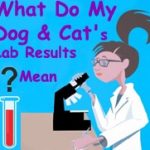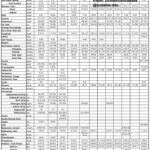Normal Dog And Cat Blood Chemistry And Lab Values
Feline & Canine Blood Chemistry Values, Temperature, Urine and Other Values for Your Dog and Cat
Ron Hines DVM PhD
 Some Reasons Your Pet’s Blood Chemistry Values Are Abnormal
Some Reasons Your Pet’s Blood Chemistry Values Are Abnormal
 Common veterinary abbreviations
Common veterinary abbreviations
 Veterinary School, Davis, California
Veterinary School, Davis, California
Your Dog And Cat’s Normal Test Reference Values
Deciding what “normal” test results are for your dog and cat is not always easy. Just as in healthy people, no two pets have exactly the same normal baseline values. So, what might be “normal” in one pet might be slightly abnormal in another. When a test result is slightly outside of your laboratory’s “normal range”, it needs to be interpreted in light of how your pet is feeling and the problems that brought your pet in for testing in the first place. It also needs to be determined more than once. The two major blood analysis corporations in North America are Antech Diagnostics and Idexx Laboratories. Although they have similar normals, they are not identical. Veterinary schools also have clinical laboratories, and each maintains its own list of what it considers to be “normal values” on its analytical machines. I added a color code to identify the laboratory source of the individual “normal values”.
You Can Read About The Actual Causes Of Many Of These Abnormal Test Result here.
In non-emergency situations, request that your pet’s blood sample be sent to a national laboratory for analysis rather than performed at your local animal hospital (read here). These large national laboratories have the staff and resources to insure the most accurate results. They also provide your local veterinarian with the backup advice of university-grade experts ready to offer assistance when your dog or cat’s test results are perplexing. It is always safest to have an abnormal test result confirmed on more than one occasion before deciding if it is truly significant
Data sources: Antech=green, Plumb’s=purple, Idexx CentralLab=dark azure, IdexxCatalyst DX™=magenta Cornell=royal blue A&M Univ. GI Lab=Orange FINN Pathologists, Harleston, UK=italics Rx=treat μmol/L=umol/L IU=iu=international units
ACTH Stimulation Test Dog: 13.8-137.9 nmol/L pre 151.75-469 nmol/L post (read here) Post result of <2 µg/dL indicative of Addison’s Cat: —
A/G ratio (albumin/globulin) Dog: 0.8-2.0 0.7-1.5 0.9-1.9 Cat: 0.35-1.5 0.8-1.5 0.6-1.4
Albumin Dog: 2.7-4.4 g/dL 2.7-3.9 3.2-4.1 Cat: 2.5-3.9 3.2-4.3 g/dL 26-42 g/l
ALP Alkaline Phosphatase (ALP) Dog: 5-131 5-160 7-115 u/L Cat: 6 -102 11-49 u/L 11-67 U/l@37C
ALT (aka SGPT) Dog: 12-118 18-121 17-95 u/L Cat: 10-100 28-109 u/L 18-77 U/l@37C
Ammonia (in blood) Dog: 2-110 μmol/L Some give <35.7 µmol/L (50 µg/mL) (read here) Cat: —
Amylase (in blood) Dog: 290-1125 322-1310 u/L Cat: 100-1200 603-2183 iu/L
ANA (antinuclear antibody) Dog : some say a titer of <10, other <40? Cat: <10, other <40 ?
Anion Gap (of blood)* Dog: 8-25 11-26 17-27 mEq/L or mmol/L Cat: 10-33 18-29 mEq/L or mmol/L
AST (aka SGOT)Dog: 15-66 16-55 18-56 u/L Cat: 10-100 17-48 u/L
Basophils Dog: 0-1% of WBCs Cat: 0-1% of WBCs
Basophils Dog: 0-150 Total #/µL 0-100/uL Cat: 0-150 Total #/µL 0
Bicarbonate Dog: 18-25 14-24 mmol/L = mEq/L 13-27 Cat: 16-22 14-20 mmol/L = mEq/L
Bile acids Dog: < 15 μmol/L < 10 μmol/L Cat: < 10 μmol/L
Bilirubin (direct/conjugated) Dog: 0-0.1 0-0.1 mg/dL Cat: 0-0
Bilirubin (indirect/unconjugated) Dog: 0-0.4 0-0.1 0-0.2 mg/dL Cat: 0-0.4 0-0.1 mg/dL
Bilirubin (total) Dog: 0.9 – 10.5 mmol/L Cat: 1.2-7.9 mmol/L
Bilirubin (total) Dog: 0.1-0.3 0.0-03 0-0.2 mg/dL Cat: 0.1-0.4 0-0.1 mg/dL
Bilirubin (in urine) Dog: Negative to 1+
Bleeding Time Dog: 2-4 minutes (clinically:< 4) Cat: 2-4 minutes
Blood (in urine) Dog: Up to 5 RBCs seen/high-power microscope field = hpf. Some say <3 Cat: the same
Blood Pressure ** (systolic at animal hospital add 20%) Dog: 120-140 mmHg Cat: 124-140 mmHg (Some vets deem 160 OK others begin Rx @ 160)
Body Temperature (rectal) Dog: 101-102.5 F, 38.3-39.2 C Cat: 101.5-102.2 F, 38.6-39 C Plumbs: Dog: 99.5-102.5 F 37.5-39.2 C
Breaths per minute Dog: 18-34 Cat: 16-40
BUN (US & Canada) Dog: 6-25 9-31 mg/dL Cat: 14-36 17-35 mg/dl
BUN (Euro & UK) Dog: 2.5-9.6 mmol/L Cat: 5.7-12.9 mmol/L
BUN/Creatinine ratio Dog: 4-27 Cat: 4-33
C-reactive protein Dog: 0-12 mg/L Cat: — mg/L
Total Calcium (in blood) Dog: 8.9-11.4 8.4-11.8 9.4-11.1 mg/dL Cat: 8.2-10.8 9.0-11.3 mg/dL
Total Calcium (in blood) Dog: 2.2-3.0 mmol/L Cat: 2.0-2.7 mmol/L 1.6 – 3.0 mmol/l
Chloride Dog: 102-120 109-122 108-119 106-114 mEq/L or mmol/L Cat: 104-128 111-124 mEq/L or mmol/L
Cholesterol Dog: 92-324 136-392 131-345 mg/dL Cat: 75-220 101-323 mg/dL
Cholesterol Dog: 3.0-6.6 mmol/L Cat: 1.8-4.2 mmol/L 0.9-6.5 mmol/l
Cholinesterase Dog: 1,895-5,240 3164-8164 u/L Cat: 736-3,016 1540-4055 u/L
CK (CPK, Creatine Kinase) Dog: 59-895 64-314 10-200 u/L Cat: 56-529 74-386 iu/L
Clotting Time (ACT activated clotting time) Dog: 55 – 80 seconds. Cat: 55 – 85 seconds
Clotting Time (buccal bleeding time) Dog: 2-4 minutes Cat: 2 – 4 minutes
CO2 (in blood) Dog: 15-25 mmol/L 13-27 Cat: 12-30 mmol/L (same as bicarbonate)
Coagulation Time (on glass) Dog: 2-4 minutes Cat: 2 – 4 minutes exposure to glass greatly reduces clotting time.
Cobalamin (vit B-12) Dog: 251-908 ng/L Cat: 290-1,500 ng/L
Cobalamin (fasting, A&M GI Lab) Dog: >300 ng/L Cat: 290-1,499 ng/L
Cortisol (resting level) Dog: 1.0-5.0 μg/dL Cat: 1.0-4.5 μg/dL
cPL (canine pancreas-specific lipase) Dog: 0–200 μg/L is within the normal reference range; 201–399 μg/L is an equivocal zone; and ≥400 μg/L is consistent with pancreatitis. (read)
C-Reactive Protein Dog: 0-7.6 mg/L
Creatinine (in blood) Dog: 0.5-1.6 0.6-1.4 0.5-1.5 mg/dL Cat: 0.6-2.4 0.8-2.1 mg/dL IRIS* considers any canine value > 1.4 or feline value > 1.6 to be evidence of kidney disease
Creatinine (in blood, Euro) Dog: 44-138 mmol/L Cat: 49-165 mmol/L 45-170 umol/l
Creatinine (in urine) Dog: 100-500 mg/dL
CRT (Capillary Refill Time) Dog: 1-2 seconds Cat: 1-2 seconds
cTLI (canine trypsin-like immunoreactivity) Dog: 5.7 – 45.2 µg/L Cat: 12.0 – 82.0 µg/L
D-Dimer (A&M) Dog: 116.2-371.5 ng/ml
Eosinophils (% Eos) Dog: 2-10% Cat: 2-12%
Eosinophils (total #) Dog: 0-1,200 /μL 70-1,490/uL Cat: 0-1,000 /μL 0.0-1.5×109/L
Fecal Alpha1 Proteinase Inhibitor Dog: 2.2-18.7 (α1-PI)μg/gm Cat: 0.04-1.6 (α1-PI)μg/gm
Fibrinogen Dog: 150-400 mg/dL Cat: 150-400 mg/dL
Fibrinogen Dog: 1-4 g/L Cat: 0.5-3 g/L
Folate (fasting) Dog: 7.7-24.4 μg/L Cat: 9.7-21.6 μg/L
fPL (feline pancreas-specific lipase) Cat: < 3.5 μg/L
Free T-4 Dog: 8-40 pmol/L Cat: 10-50 pmol/L
Free T-4 (FT4) Dog: 0.6-3.7 ng/dL Cat: —
Fructosamine Dog: (Unv of GA Lab): 258-343, 266-381 μmol/L, Dog (Kansas State U): 136-350 μmol/L Cat: 175-400 219-365 μmol/L
Gestation Period (pregnancy) Dog: 62-63 days Cat: 63–64 days
GGT (GGTP aka Gamma GT) Dog: 1-12 0-8 0-13 u/L Cat: 1-10 0-2 u/L 0.1-9.0 U/l@37C
GLDH (Glutamate dehydrogenase, GDH) Dog: 1-20 u/L Cat: 0-12 u/L
Globulin (total in blood) Dog: 1.6-3.6 1.9-3.7 g/dL 2.4-4.0 Cat: 2.3-5.3 2.9-4.7 g/dL
Globulin (total in blood) Dog: 1.6-3.6 2.4-4.0 g/dL Cat: 23-53 g/L 15-57 g/l
Glucose (in blood) Dog: 70-138 68-104 63-114 mg/dL Cat: 64-170 71-182 mg/dL
Glucose (in blood) Dog: 4.4-8.3 mmol/L Cat: 3.9-9.4 mmol/L 3.8-7.6 mmol/l
Hb A1c (%) College of Vet Med, Kansas State U.: 4% or less
HCO3 (buffering capacity of venous blood) Dog: 19-24 mEq/L Cat: 19-24 mEq/L
Heart Rate Dog: 70-120 beats/minute Cat: 120-170 beats/minute
Hematocrit (PCV, Hct) Dog: 36-60 38.3-56.5 41-58 % Cat: 29-48 31-48 % 27-50 %
Hemoglobin (Hg) Dog: 12.1-20.3 14.1-20 g/dL 13.4-20.7 Cat: 9.3-15.9 10.9-15.7 g/dL 8.0-15g/dl
Hemoglobin (Hg) Dog: 120-180 g/L Cat: 80-150 g/L
Insulin (blood level) Dog: 5-20 μunits/ml Cat: 5-20 μunits/ml
Iron (serum level) Dog: 46-241 97-263 μg/dL Cat: 42-165 59-169 μg/dL
Ionized Calcium Dog: 5.0-6.0 mg/dL Cat: 4.6-5.5 mg/dL
Ionized Calcium Dog: 1.24-1.43 1.16-1.40 mmol/L Cat: 1.16-1.34 1.11-1.38 mmol/L
Iron Binding Capacity (TIBC) Dog: 363-475 μg/dL Cat: 296-318 μg/dL
LDH (lactate dehydrogenase) Dog: 20-500 24-388 u/L Cat: 20-500 71-406 u/L
Lipase Dog: 77-695 15-228 u/L Cat: 10-205 7-23 u/L
Lipase-DCL Dog: 65-691 u/L Cat: 5-222 u/L
Lipase Pancreas-Specific Dog: cPLI: A&M 0-200 Cat: fPLI: Antech 2.0–6.8 µg/L A&M 0-3.5 µg/L
Lipase (Precision PSL™) Dog 24-140 u/L Cat: 8-26 u/L
Lymphocyte Dog: 12-30% of WBC count Cat: 20-45% of WBC count
Lymphocyte Total number Dog: 690-4,500 /µL 1,060-4,950/uL Cat: 1,200-8,000 /µL 1.5-7.0×109/L
Magnesium Dog: 1.5-2.5 1.5-2.1 mEq/L Cat: 1.5-2.5 1.7-2.2 mEq/L
Magnesium Dog: 0.7-1.1 mmol/L Cat: 0.8-1.2 mmol/L
MCH (mean corpuscular hemoglobin) Dog: 19-28 21.9-26.1 21-26 pg Cat: 11-21 13-17 pg 11.5-16.7 pg (=Picograms)
MCV (mean corpuscular volume) Dog: 58-79 64-76 59-76 /fL = μm3 Cat: 37-61 40-52/fL= /μm3 37.1-54.7 fl
MCHC (mean corpuscular hemoglobin concentration) Dog: 30-38 33-36 32.6-39.2 g/dL Cat: 30-38 32-35 g/dL 28.3-34.3 g/dl
Microalbumin (in urine) Dog: <2.5 mg/dL Cat: <2.5 mg/dL
Monocyte (in blood) Dog: 3-10% of WBC count Cat: 1-4% of WBC count
Monocyte (in blood aka absolute) Dog: 0-840 130-115 /µL Cat: 0-600 /µL 0.0-0.8×109/L
M:E ratio (Myeloid/erythroid ratio) Dog: 0.75-2.5:1 Cat: 0.6-3.9:1
Myoglobin Dog: 0 Cat: 0 should not be in blood or urine
Neutrophil (total %) Dog: 60-77 % of WBC count Cat: 35-75 % of WBC count
Neutrophil (total number aka absolute) Dog: 2,060-10,600 2,940-12,670 /uL 2.7-9.4 x103/µL Cat: 2,500-8,500 /µL 2.3-11.6 x103/µL 2.5-12.5 x109/L
Neutrophil (total % immature Band neutros) Dog: 0-3% of WBC count Cat: 0-3% of WBC count
Neutrophil (total number of Band neutros) Dog: 0-300 /µL Cat: 0-150 /µL
Osmolality (of blood) Dog: 277-311 mOsm/L Cat: 299-330 mOsm/L
PCO2 (of venous blood) Dog: 40-45 mmHg Cat: 40-45 mmHg
PCV (packed cell volume = hematocrit) Dog: 37-55 42-54 % Cat: 29-45 31-48 %
pH (of blood) Dog: 7.32-7.42 Cat: 7.24-7.40
pH (of urine) Dog: 5.5-7.0 Cat: 5.5-7.0
Phosphate (in blood) Dog: 2.3-6.5 2.7-5.4 mg/dL Cat: 2.7-6.5 2.6-5.5 mg/dL 0.7 – 2.1 mmol/l
Phosphorus (in blood) Dog: 2.5-6.0 2.5-6.1 mg/dL Cat: 2.4-8.2 mg/dL Most vets begin Rx @4-4.6 for CKD
Phosphorus (in blood) Dog: 1.0-2.0 mmol/L Cat 1.3-2.4 mmol/L
Phosphorus (in blood) Dog: 2.8-6.2 mg/dcL 2.5-6.1 Cat: 3.7-9.3 mg/dcL
Platelets (estimated) Dog: “adequate” Cat: “adequate” 200-600 x109/L
Platelet Count Dog: 2-9 x 105/µL3 143-448 K/uL Cat: 3-7 x 105/µL3
Platelet Count Dog: 170-400 x 109/L or 103/µL Cat: 200-500 x 109/L or 103/µL
Potassium Dog: 3.6-5.5 3.5-5.8 4.0-5.4 4.1-5.4 mEq/L or mmol/L Cat: 3.4-5.6 3.8-5.5 3.4-5.6 mEq/L or mmol/L
Protein:Creatinine UPC ratio (urine) Dog: <or = 0.5 Cat: <or = 0.5
Protein (TP total in blood) Dog: 5.0-7.4 gm/dL Cat: 5.2-8.8 gm/dL
Protein (TP in blood plasma) Dog: 55-75 gm/L Cat: 57-80 gm/L
Protein (TP in blood serum) Dog: 50-75 gm/L Cat: 60-82 gm/L
Protein (in urine) Dog & Cat mg/dL varies depending on how dilute your pet’s urine sample is.
Prothrombin Time Dog: 10-25 seconds Cat: 10-25 seconds
PTH (parathyroid hormone) Dog: 20-130 Cat: 0-40
PTH (parathyroid hormone) Dog: 2-13 pmol/L Cat: 0-4 pmol/L
PTH (parathyroid hormone N-terminal) Dog: 15-55 pg/ml Cat: 8-28 pg/ml =Picograms
PTHrP (parathyroid hormone-related protein) Dog: — Cat: 0-1 pmol/L
Pulse Rate Dog: 70-120 beats/minute Cat: 120-170 beats/minute
Red Blood Cells (RBC = erythrocytes) Dog: 4.8-9.3 x 106 /μL or mm³ 5.39-8.70 also=M/uL 5.39-8.7 Cat: 5.92-9.93 x 106 /μL or mm³ 5.5-10 x1012/L
RDW (red blood cell distribution width) Dog: 14-19 10.6-14.3 % Cat: 14-31 13.2-17.5 %
Respiratory rate Dog: 18-34 breaths/minute Cat: 16-34 breaths/minute
Reticulocytes Dog: 0-1.5% 0.2-1.5 of RBCs Cat: 0.2-1.6% 0.1-0.7 of RBCs
Reticulocytes Dog: 10-110 K/uL Cat —
Reticulocytes Dog: 11-92 x109/L Cat: 9-61 x109/L
Reticulocyte Hemoglobin (CHr iron in bone marrow, Dx iron deficiency [read here]) Dog: 22.3-29.6 pg =Picograms
SDH (succinate dehydrogenase) Dog: 3.1-19 3-13 u/L Cat: 2.4-12 1-11 u/L
SDMA (symmetric dimethylarginine) Dog: 0-14 µg/dL Cat: 0-14 µg/dL 1.0-14.0 ug/dl
Sodium (Na in blood) Dog: 139-154 mEq/L or mmol/L 144-160 142-152 143-150 Cat: 145-158 mEq/L, 150-165 149-158 mEq/L or mmol/L
Sodium to Potassium Ration (NA/K ratio) Dog: 27-38 28-37 Cat: 32-41
Specific Gravity (SG of urine, first void of the morning) Dog: 1.015-1.050, Idexx & IRIS: 1.015-1.045, Osborne: 1.040-1.065 Cat: 1.015-1.060, Idexx & IRIS: 1.035-1.060, Osborne: 1.045-1.085
Spec fPL (feline specific pancreatic lipase) Dog: not applicable Cat: 0.1-3.5 μg/L
T 3 (thyroid hormone) Dog: 45-150 ng/dL Cat: 40-150 ng/dL
T 4 (thyroid hormone) Dog: 0.8-3.5 0.8-2.9 1.0-4.0 μg/dL Cat: 0.8-4.0 μg/dL 7.5-55.0 nmol/l
Taurine (in plasma) Dog: — Cat: 80-120 nmol/L
TCO2 (~ bicarbonate) Dog: 17-24 mEq/L 13-27 mmol/L Cat: —
TIBC (total iron-binding capacity) Dog: 235-495 280-489 μg/dL Cat: 203-398μg/dL 222-423 μg/dL
TLI (trypsin-like immunoreactivity, fasting) Dog: 5.7-45.2 μg/L Cat: 12-82 μg/L
Total Protein (in blood) Dog: 5.0 – 7.4 5.5-7.2 g/dL 5.5-7.5 Cat: 5.2 – 8.8 6.6-8.4 g/dL 56 – 81 g/l
Total Protein (in urine) Dog & Cat mg/dL varies depending on how dilute your pet’s urine sample is.
Triglycerides Dog: 29-291 23-102 mg/dL Cat: 25-160 30-106 mg/dL
TSH (cTSH) Dog: 0-0.6 milli–international units/L 13-38 % of hypothyroid dogs have TSH concentrations within the normal reference range
Urea Nitrogen aka BUN (US & Canada) Dog: 6-25 mg/dL Cat: 14-36 mg/dL
Urea Nitrogen aka BUN (Euro, UK, etc.) Dog: 2.5-7.0 mmol/L or 2.5-9.6 Cat: 5.0-11 mmol/L or 5.7-12.9 depending on the laboratory
Urea (the entire urea molecule, rather than just the nitrogen portion reported as BUN is sometimes what is measured outside of N. America. Dog: 8.7-30.5 mg/dL Cat: 13.4-32.5 mg/dL 6.1-12.5 mmol/l
Uric Acid Dog: 0.2-0.9 0.1-0.4 mg/dL Cat: 0-0.5 0-0.3 mg/dL
Protein:Creatinine ratio (UPC in urine) Dog: < 0.5 Cat: < 0.4 NCSU give dog and cat UPC normals as < 0.4 and <0.2
Vitamin D3 (in blood) Dog — Cat: 125-335 nmol/L Some vets suggest supplement @200
White Blood Cell Count (WBC, leukocytes) Dog: 4.0-15.5 5.7-14.2 4.9-17.6 x 103 cells/μL or mm³ Cat: 3.5-16.0 5.1-16.2 x 103 cells/μL or mm³ 4.0-15.0 x109/L
White Blood Cells (WBCs seen in urine) Dog: 0 – 3 Idexx 0-5 /high-power microscope field Cat: same as dog
* IRIS = International Renal Interest Society
DxMe
You are on the Vetspace animal health website
Visiting the products that you see displayed on this website help pay the cost of keeping these articles on the Internet.

